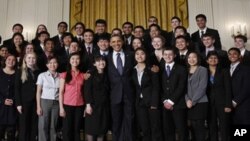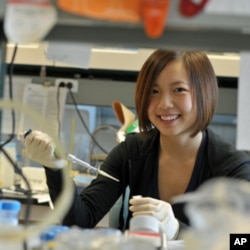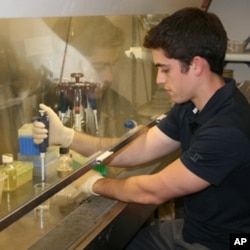Some of America's brightest students came to Washington for the 2011 Intel Science Talent Search, the nation’s oldest and most prestigious science competition.
The awards ceremony was the culmination of an intense week during which the 40 finalists were queried by judges and the public. They met with scientists, politicians and even President Barack Obama, who welcomed them to the White House.
These high achievers were whittled down from nearly 2,000 contestants nationwide, representing excellence across many disciplines.
"These students bring work that is ready for publication and in many cases has already been published in pretty much any branch of science that you can think of: physics, electrical engineering," says Wendy Hawkins, executive director of the Intel Foundation, which sponsored of the event. "And the projects are deep and rich and insightful."
Those projects contribute serious new scientific data and analysis. Selena Li, a 17-year old first-generation Chinese-American from Sacramento, California, is working on a more effective treatment for liver cancer.
"It is a huge problem in Asia and Africa. The problems with liver cancer is the five year survival rate is 10 percent, whereas for other cancers it’s 80 percent or more," says Li. "There is a major lack of viable treatments for liver cancer so I really wanted to look into that field."
Li began that quest four years ago. She found a mentor at the University of California who taught her how to design and execute experimental work in the laboratory.
"I researched a new approach to targeting liver cancer by basically starving the cancer cells to death, while leaving the normal cells unaffected," she says. "And to go one step further, I blocked a survival pathway to make the treatment more effective."
Li placed fifth in the Intel Science Talent Search, with a $30,000 award. She says the work was time-consuming, but she has no regrets.
"Despite the multiple times I’ve had to stay in the lab until twelve or come in before school to do my experiments, it was an incredibly rewarding experience. Despite all of the frustrations, I think that I’ve gotten a lot out of my research experience and I encourage other people to do this."
Scott Boisvert agrees. He’s from a suburb of Phoenix, Arizona. At 14, he approached the University of Arizona to request time in their laboratory. Over the course of four years he refined a project studying a fungus linked to the decline of amphibians across the globe.
"It is actually the largest mass extinction since the dinosaurs," says Boisvert. "I was trying to see if different chemistry in the environment, different chemicals and substances in the water across Arizona, could potentially kill the fungus and stop its spread and infection of the amphibians."
Boisvert collected and tested the water samples. "My results were able to identify a list of the chemicals that were significant in the growth and in the movement of the fungus."
According to Boisvert, his research has been accepted for publication in a professional science journal. He hopes his findings help guide habitat conservation managers around the world. At the Intel Science Talent Search, the work earned him a 10th place finish and a $20,000 award.
"It’s been an incredible opportunity for me and really the capstone of all that I’ve been able to do in high school," Boisvert says.
He and Li both plan to be physicians and medical researchers. Their achievements are a reminder of what high school students can achieve.
"All of these students are scientists," says Hawkins, the talent search executive director. "They have those abilities, that knowledge and that approach to look at the world. These students go on and do wonderful things in ways both expected and unexpected."
Hawkins says the gifted students also serve as examples for others to follow, and represent the next generation of innovators who will shape America’s future.












